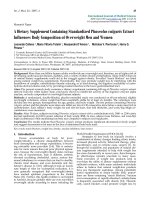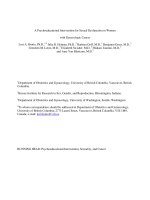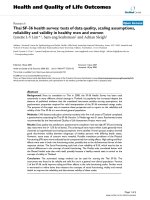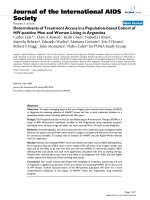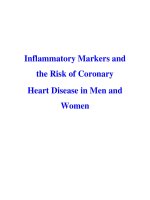Ebook Dx/Rx: Sexual dysfunction in men and women – Part 2
Bạn đang xem bản rút gọn của tài liệu. Xem và tải ngay bản đầy đủ của tài liệu tại đây (3.45 MB, 94 trang )
S E C T I O N
2
Female Sexual
Dysfunction
71966_07CH_pgs_077-094_Zaslau.indd 77
8/31/10 9:34 AM
71966_07CH_pgs_077-094_Zaslau.indd 78
8/31/10 9:34 AM
C H A P T E R
7
Physiology of Female
Sexual Function
Chad P. Hubsher, MD Ⅲ Adam Luchey, MD Ⅲ Stanley
Zaslau, MD, MBA, FACS
■ Introduction
■
■
■
Sexual function in women is a highly variable, multifaceted process involving several components:
• Anatomical
• Physiological
• Psychological
• Emotional
• Interpersonal
Given the complex nature of sexuality in females, little
consensus currently exists on the definition of a “normal
sexual response.”
Although aspects of female sexual function, such as vaginal
lubrication and orgasmic contractions, seem to be widespread in normal, sexually functioning women, the subjective or emotional aspects are highly individual. These
aspects are subject to learning and cultural factors, as past
experiences play an important role in shaping expectations
regarding sexual response in women.
■ Female Sexual Response Cycle
■
■
Over the past 45 years, several models have been proposed to aid in the understanding of the female sexual
response cycle.
These models provide a conceptual framework of the
sequence of physiological events and psychological processes that comprise normal sexual response for most
79
71966_07CH_pgs_077-094_Zaslau.indd 79
8/31/10 9:34 AM
80 Chapter 7
women. However, to date, none of the proposed female
sexual response models have been shown to be universally applicable.
The Masters and Johnson (Four-Stage) Model
■ Masters and Johnson first characterized the female sexual response cycle in 1966 based on laboratory observations of approximately 700 men and women.1
■ They proposed a model of female sexual response consisting of four successive phases, each of which has associated genital and extragenital responses (Figure 7.1):
• Excitement
• Plateau
• Orgasm
• Resolution
The Three-Stage Model
■ In 1974, Kaplan proposed a three-stage model that acknowledged the importance of subjective, psychological,
and interpersonal aspects of sexual response.2
■ In this model, the sexual response cycle was reconceptualized to consist of three essential phases:
• Desire
• Arousal
• Orgasm
■ This three-stage model was used in the fourth edition of
the Diagnostic and Statistical Manual of Mental Disorders
(DSM-IV) as the basis for the classification of female
sexual dysfunction. It was also used in the American
Foundation of Urologic Disease’s 1998 reclassification
per their first international consensus development panel
on female sexual dysfunction.3
■ Female Sexual Anatomy
■
In order to adequately understand female sexual function, it is necessary to have a formal understanding of the
female pelvic anatomy.
71966_07CH_pgs_077-094_Zaslau.indd 80
8/31/10 9:34 AM
71966_07CH_pgs_077-094_Zaslau.indd 81
Desire
Arousal
Time
Orgasm
Resolution
Figure 7.1 The Masters and Johnson Model
Source: Adapted from Masters WH & Johnson VE. Human Sexual Response. Boston, MA: Little Brown
& Co.; 1966.
Sexual
excitement/
tension
Plateau
Resolution
Physiology of Female Sexual Function 81
8/31/10 9:34 AM
82 Chapter 7
■
The organs and structures can be grouped into external
and internal genitalia.
• The external genitalia, collectively known as the vulva,
consist of:
■ The labial formation
■ Interlabial space
■ Erectile tissues, including the clitoris and vestibular bulbs
• They are bound anteriorly by the pubic symphysis, laterally by the ischial tuberosities, and posteriorly by the
anal sphincter.
• The internal genitalia consist of the:
■ Vagina
■ Uterus
■ Fallopian tubes
■ Ovaries
■ Pelvic floor muscles
Labial Formation
■ The labial formation is designed to provide protection
to the urethral and vaginal orifices, both of which open
into the vestibule of the vagina.
■ It consists of two pairs of symmetrically folded skin; the
outer folds, known as the labia majora, fuse with each
other anteriorly at the anterior labial commissure, while
the inner folds, known as the labia minora, are continuous with the vaginal mucosa and fuse together to form
the prepuce of the clitoris anteriorly, and the frenulum
posteriorly.
■ The labia majora are composed of subcutaneous fat and
covered by hair-bearing skin, while the labia minora
are covered by hairless skin and are composed of a fatfree spongy tissue punctuated by sebaceous and sweat
glands along with many blood vessels and sensory nerve
endings.
■ The labial formation is innervated by the perineal and
posterior labial branches of the pudendal nerve. The arterial blood supply is derived from the inferior perineal and
posterior labial branches of the pudendal artery, as well
as superficial branches of the femoral artery.
71966_07CH_pgs_077-094_Zaslau.indd 82
8/31/10 9:34 AM
Physiology of Female Sexual Function 83
Interlabial Space
■ The area medial to the labia minora, bound anteriorly by the clitoris and posteriorly by the frenulum, is
known as the interlabial space.
■ The urethral orifice, vaginal orifice, and greater vestibular
gland, also known as Bartholin glands, all open into this
space.
• The greater vestibular glands are located in the superficial perineal pouch, underneath the bulbs of the
vestibule, and secrete a small amount of lubricating
mucus into the vestibule of the vagina during sexual
arousal.
Clitoris
■ The clitoris is an erectile organ similar to the penis that
arises from the same embryological structure, the genital
tubercle.
■ It is cylindrical in shape, located posterior to the anterior
labial commissure, and composed of three parts:
• The outermost glans or head
• The middle corpus or body
• The innermost crura
■ The glans clitoris is often hidden by the labial formations
when nonengorged, but may be visualized as it emerges
from the labia minora.
■ The body of the clitoris extends beneath the skin and
gives rise to bilateral crura, called corpora cavernosa,
which, similar to the penis, are composed of erectile tissue and separated by a septum.
■ The paired crura of the clitoris are homologous to the
male corpora and are comprised of:
• Lacunar sinusoids
• A trabecula of vascular smooth muscle
• A collagen connective tissue surrounded by a thick fibrous sheath known as the tunica albuginea
■ Unlike the bilaminar structure found in the penis, the tunica albuginea in the clitoris is unilaminar. There is thus
no mechanism for venous trapping in the clitoris and as a
result, sexual stimulation produces clitoral engorgement,
not erection, as is seen in the penis.
71966_07CH_pgs_077-094_Zaslau.indd 83
8/31/10 9:34 AM
84 Chapter 7
■
■
■
■
During sexual stimulation, blood flow to the clitoris almost
doubles, resulting in an increase in length and diameter,
as was demonstrated by Park and colleagues using duplex
ultrasounds.4
The iliohypogastric arterial bed is the main arterial supply to the clitoris. The internal iliac artery traverses the
pudendal canal (Alcock’s canal), after it gives off its last
anterior branch, the internal pudendal artery.
• The internal iliac then terminates as the common clitoral artery, which gives off the dorsal clitoral artery
and clitoral cavernosal arteries.
• It is these arteries that are responsible for engorgement of the corporeal bodies upon sexual stimulation
and arousal.
The nerve endings located in the clitoris are comprised of
autonomic and somatic innervation.
• The autonomic innervation of the clitoris is formed by
the pelvic and hypogastric plexuses. These plexuses
carry sympathetic (T1-L3) and parasympathetic (S2S4) fibers that join together at the base of the broad
ligament, on each side of the supravaginal part of the
cervix, to form the uterovaginal plexus and send direct
fibers to both the clitoris and vagina.
• Somatic sensory innervation of the clitoris arises in
the skin and travels to the sacral spinal cord via the
dorsal nerve of the clitoris and pudendal nerve.
Within the clitoris there is a dense collection of Pacinian
corpuscles, Meissner’s corpuscles, and Merkel tactile
disks, which are responsible for transmitting information
to the brain concerning pain and pressure, light touch,
and texture, respectively.
Vestibular Bulbs
■ The other erectile tissues of the female genitalia are the
vestibular bulbs.
■ These are 3-cm-long paired structures that lie beneath
the skin of the labia minora, directly along the sides of
the vaginal orifices.
■ They are homologous to the corpus spongiosum of the
penis. However, unlike the penis, the vestibular bulbs
71966_07CH_pgs_077-094_Zaslau.indd 84
8/31/10 9:34 AM
Physiology of Female Sexual Function
■
85
are separated from the clitoris, urethra, and vestibule
of the vagina.
The recent cadaver dissections of O’Connell and associates revealed that the bulbs lie on the superficial aspect
of the vaginal wall, not forming the core of the labia minora. They also discovered that there are considerable
age-related variations in the dimensions of the vestibular bulbs in young, premenopausal women versus older,
postmenopausal women.5
Vagina
■ The vagina is a midline cylindrical organ that is approximately 7–9 cm in length.
■ It extends from the cervix of the uterus to the vestibule
of the vagina, and its walls are composed of four layers:
• An inner mucosal layer
■ The inner vaginal mucosa is a stratified squamous
nonkeratinized mucus type epithelium that undergoes hormone-related cyclical changes during the
menstrual cycle in which a slight keratinization of
the superficial cells occurs.
• A lamina propia
■ The lamina propia separates the mucosal layer and
the muscularis.
• A muscularis layer
■ The vaginal muscularis is composed of outer longitudinal and inner smooth muscle cell fibers, as well
as an extensive tree of blood vessels.
• An outer adventitial supportive mesh layer
■ The surrounding outermost fibrous layer is rich in
collagen, and provides structural support to the vagina. It is this outermost layer that is responsible
for expansion of the vagina during childbirth and
intercourse.
■ During sexual arousal, there is increased blood flow to the
subepithelial blood vessels, resulting in genital vasocongestion and subsequent engorgement of the vaginal wall.
■ According to Levin, the increase in pressure inside the
subepithelial vascular bed results in passive transudation
of plasma through the vaginal epithelium.6 Along with
71966_07CH_pgs_077-094_Zaslau.indd 85
8/31/10 9:34 AM
86 Chapter 7
■
■
secretions from the uterine glands, this helps lubricate
the vaginal canal.
• Initially, as the vaginal lubricative plasma flows onto
the surface of the vagina, sweatlike droplets form.
These eventually coalesce to create a lubricative film
covering the vaginal wall.
• Further moistening during sexual arousal originates
from secretions of the greater vestibular glands located in the interlabial space.
The nerve endings located in the vagina are comprised of
autonomic and somatic innervation.
• The uterovaginal nerves, which originate from the
hypogastric and sacral plexuses, contain both parasympathetic and sympathetic fibers, and supply
autonomic innervation to the proximal two-thirds
of the vagina, as well as the corporeal bodies of the
clitoris.
• The uterovaginal nerve fibers, which travel within the
uterosacral and cardinal ligaments before reaching the
vagina, play a major role in sexual function, and thus
serve as a potential site of injury and resultant sexual
dysfunction from female pelvic surgery.
• The somatic sensory innervation of the vagina is primarily provided by the pudendal nerve.
The arterial supply to the vagina varies by location.
Vaginal branches of the uterine artery supply the superior
aspect of the vagina, the hypogastric artery supplies the
middle vagina, and branches of the middle hemorrhoidal
and clitoral arteries supply the distal aspect of the vagina.
Uterus
■ The uterus is a midline, mobile organ located between
the rectum and urinary bladder that connects with the
proximal aspect of the vaginal canal via the cervical os.
■ During sexual arousal, uterine and cervical glands secrete
mucus to help lubricate the vaginal canal.
■ Surgical menopause, brought on by hysterectomy with
oophorectomy, significantly impacts sexual function.
• Furthermore, as described by Carlson, hysterectomy
alone, without removal of the ovaries, can also result
71966_07CH_pgs_077-094_Zaslau.indd 86
8/31/10 9:34 AM
Physiology of Female Sexual Function 87
in sexual dysfunction postoperatively.7 Removal of
the uterus disrupts the pelvic autonomic and cervical
plexus, as well as the uterosacral and cardinal ligaments and the associated autonomic fibers. As previously discussed, this disturbs innervation to the vagina
and clitoris, resulting in alteration in sexual function.
Pelvic Floor Muscles
■ The pelvic floor is a collection of tissues that span the
opening within the bony pelvis and function to:
• Support the abdominal and pelvic organs
• Maintain continence of urine and stool
• Allow for parturition and intercourse
■ Pelvic support is primarily provided by the levator ani
muscles, urogenital diaphragm, and the perineal membrane, which consists of the ischiocavernosus, bulbocavernosus, and superficial transverse perineal muscles.
• Voluntary contraction of the perineal membrane plays
a role in sexual response by intensifying orgasm of
both the female and male partner.
■ The pelvic floor muscles can also cause sexual dysfunction.
• At times, nonvoluntary pelvic floor spasms are associated with vaginal penetration.
• Laxity and hypotonia of the pelvic floor result in symptoms of vaginal anesthesia, coital anorgasmia, and incontinence during intercourse or orgasm.
• Women with pelvic floor disorders often present with
coexisting urological and sexual complaints.
■ Female Sexual Response
■
■
The female sexual response cycle, described earlier, is
initiated by neurotransmitter-mediated vascular and nonvascular smooth muscle relaxation. The result is:
• Increased pelvic blood flow
• Vaginal lubrication
• Clitoral and labial engorgement
These mechanisms are mediated by a combination of
neuromuscular and vasocongestive events that are under
neurogenic and hormonal regulation.
71966_07CH_pgs_077-094_Zaslau.indd 87
8/31/10 9:34 AM
88 Chapter 7
■ Physiology of Sexual Arousal
■
■
■
Sexual arousal in the female is associated with a variety
of changes in the female sexual anatomy.
The increase in pelvic blood flow via the iliohypogastric
arterial bed, and simultaneous relaxation of the vaginal
wall and clitoral cavernosal smooth muscle, is responsible for the observed engorgement of the labia minora,
vagina, and clitoris during sexual arousal.
• In the labia minora, the increase in blood flow, especially to the vestibular bulbs that lie directly beneath
the skin of the labia, result in a two- to threefold increase in diameter of the labia, along with eversion
and exposure of its inner surface.
• In the vagina, the infiltration of blood in the extensive
vasculature of the muscularis layer leads to vaginal
wall engorgement and a concomitant expansion of the
outermost fibrous layer to allow continued structural
support of the vaginal canal.
• Via the clitoral cavernosal arteries, the clitoris also experiences an enhancement blood flow during sexual
arousal. The resultant increase in intracavernous pressure leads to extrusion and tumescence of the glans
clitoris, unlike the rigidity as seen in the male penis.
■ Goldstein and Berman reported that unlike the penis, the clitoris lacks a subalbugineal layer between
the tunica albuginea and erectile tissue.8
■ The subalbugineal layer in the male contains a rich
venous plexus, and with sexual arousal, will expand
against the tunica albuginea, causing a reduction in
venous outflow and inducing rigidity in the penis.
■ Consequently, the absence of this venous plexus
and subalbugineal layer in the clitoris allows only
tumescence to be obtained.
Increased lubrication of the vaginal canal during sexual
arousal is achieved primarily via two mechanisms: transudate originating from the subepithelial vascular bed and
secretions from uterine glands.
• As previously described, vaginal engorgement enables
a process of plasma transudation to occur, in which
71966_07CH_pgs_077-094_Zaslau.indd 88
8/31/10 9:34 AM
Physiology of Female Sexual Function
89
increased pressure within the blood vessel helps transudate to form and plasma to flow through the epithelium and eventually create a lubricative film that
covers the vaginal wall.
• Additional vaginal canal moistening during sexual
arousal comes from secretions of the greater vestibular
glands (Bartholin’s glands).
• Furthermore, as reported by Toesca and colleagues,
these secretions may also serve as a mechanism to attract the male sex by emitting fluid that is odiferous.9
Neurogenic Mediators
■ Which and how neurotransmitters modulate vaginal
and clitoral smooth muscle tone are currently being
investigated.
■ Recently, Burnett and colleagues and Hilliges and colleagues identified nitrous oxide (NO) and phosphodiesterase type 5 (PDE-5) in both clitoral and cavernosal
smooth muscle.10,11
• PDE-5 is the enzyme responsible for the degradation
of cGMP, as well as formation of NO.
• These neurotransmitters may serve as a potential therapeutic site for sexual dysfunction.
■ Vemulapalli and Kurowski determined that sildenafil, a specific PDE-5 inhibitor, causes dosedependent relaxation of female rabbit clitoral and
vaginal smooth muscle in organ bath studies.12
■ Park and associates suggest that NO, in combination
with vasoactive intestinal peptide (VIP), are involved in
regulation of vaginal secretory processes and relaxation.13
• VIP is a nonadrenergic, noncholinergic neurotransmitter that has been described by Levin to enhance
vaginal blood flow, lubrication, and secretions.14
• Similar to the aforementioned studies performed with
PDE-5, Ziessen and colleagues determined that VIP
causes dose-dependent relaxation of rabbit clitoral
cavernosum and vaginal smooth muscle in organ bath
studies.15
■ Thus, in addition to NO and PDE-5, there may be
a role of endogenous VIP as a neurotransmitter in
71966_07CH_pgs_077-094_Zaslau.indd 89
8/31/10 9:34 AM
90 Chapter 7
clitoral and vaginal tissue and a mediator of female
sexual response.
Hormonal Regulators
■ Female sexual function is greatly affected by the levels of hormones in the body, specifically estrogen and
testosterone.
Estrogen
■ As was demonstrated by Natoin and associates, estrogens
have vasoprotective and vasodilatory effects that increase
arterial blood flow to the vagina, clitoris, and urethra.16
• This prevents atherosclerotic compromise to the iliohypogastric arterial bed and thus helps maintain the
female sexual response.
■ Sarrel found that a decline in circulating estrogen levels, either due to aging or surgical castration, results in
increased vaginal wall fibrosis caused by decreased vaginal NO levels.17 This is because estrogen regulates nitric
oxide synthase (NOS), the enzyme responsible for production of NO.
■ Furthermore, it has been demonstrated that estrogen
replacement therapy:
• Increases vaginal NOS expression and NO levels
• Restores vaginal mucosa
• Decreases vaginal mucosal cell death
■ In addition to having a significant role in preserving vaginal mucosa, estrogen is important in the maintenance and
function of the vaginal epithelium and smooth muscle
cells of the muscularis, and in lubrication of the vaginal
canal.
■ In fact, in animal studies performed by Berman and colleagues, a decline in the level of estrogen results in a less
acidic vaginal environment and thinner and drier vaginal
walls that damage more easily.18
• These results likely correlate with complaints of female
sexual dysfunction, including vaginal dryness and dyspareunia, often seen in women with a decline in circulating
estrogen levels observed during aging and menopause.
71966_07CH_pgs_077-094_Zaslau.indd 90
8/31/10 9:34 AM
Physiology of Female Sexual Function 91
Testosterone
■ Similar to estrogen, testosterone also has a significant
effect on female sexual function; however, the role of
androgens remains controversial, as little is understood
about their exact mechanism.
■ Nonetheless, low levels of testosterone are associated
with a decrease in:
• Libido
• Sexual arousal
• Sexual responsiveness
• Genital sensation
• Orgasm
■ In a study by Sherwin and Gelfand, menopausal women
responded better to estrogen-androgen combinations
compared to estrogen alone on measures of enhanced
sexual desire, sexual arousal, enjoyment of sex, and number of orgasms.19
■ In a study by Shifren and associates of women with hypothalamic amenorrhea, testosterone increased vaginal
vasocongestion, as measured by plethysmography during
exposure to a potent visual stimulus.20
■ While pharmacological doses of testosterone have been
shown to improve overall female sexual function, it is not
known whether physiological testosterone replacement
will produce clinically meaningful changes.
■ Additionally, all androgens carry the risk of inducing virilization in women. Early reversible manifestations include
acne, hirsutism, and menstrual irregularities, while longterm side effects are often irreversible, including malepattern baldness, hypertrophy of the clitoris, and voice
changes.
■ Conclusions
■
■
Although there are significant anatomical, embryological,
and physiological parallels between men and women, it is
important to have a clear understanding of the differences.
The multifaceted nature of female sexuality further contributes to the complexity in differentiating a normal sexual response from female sexual dysfunction.
71966_07CH_pgs_077-094_Zaslau.indd 91
8/31/10 9:34 AM
92 Chapter 7
■ References
1.
2.
3.
4.
5.
6.
7.
8.
9.
10.
11.
12.
13.
14.
Masters WH, Johnson VE. Human Sexual Response. Boston,
MA: Little, Brown & Co.; 1966.
Kaplan HS. The New Sex Therapy. London, England:
Bailliere Tindall; 1974.
Basson R, Berman J, Burnett A, et al. Report of the international consensus development conference on female
sexual dysfunction: definitions and classifications. J Urol.
2000;163:888–893.
Park K, Goldstein I, Andry C, Siroky MB, Krane RJ, Azadzoi
KM. Vasculogenic female sexual dysfunction: the hemodynamic basis for vaginal engorgement insufficiency and clitoral erectile insufficiency. Int J Impot Res. 1997;9:27–37.
O’Connell HE, Hutson JM, Anderson CR, Plenter RJ.
Anatomical relationship between urethra and clitoris. J Urol.
1998;159:1892–1897.
Levin RJ. The physiology of sexual function in women. Clin
Obstet Gynecol. 1980;7:213–252.
Carlson KJ. Outcomes of hysterectomy. Clin Obstet
Gynecol. 1997;40:939–940.
Goldstein I, Berman JR: Vasculogenic female sexual dysfunction: vaginal engorgement and clitoral erectile insufficiency syndromes. Int J Impot Rs. 1998;10:S84–S90.
Toesca A, Stolfi VM, Cocchia D. Immunohistochemical
study of the corpora cavernosa of the human clitoris. J Anat.
1996;188:513–520.
Burnett AL, Calvin DC, Silver RI, Peppas DS, Docimo SG.
Immunohistochemical description of nitric oxide synthase
isoforms in human clitoris. J Urol. 1997;158:75–80.
Hilliges M, Falconer C, Ekman-Ordeberg G, Johanson O.
Innervation of human vaginal mucosa as revealed by PGP
9.5 immunohistochemistry. Acta Anat. 1995;153:119–126.
Vemulapalli S, Kurowski S. Sildenafil relaxes rabbit clitoral
corpus cavernosum. Life Sci. 2000;67:23–29.
Park K, Moreland RB, Goldstein I, Atala A, Traish A.
Characterization of phosphodiesterase activity in human
clitoral corpus cavernosum smooth muscle cells in culture.
Biochem Biophys Res Commun. 1998;249:612–617.
Levin RJ. VIP, vagina, clitoral and periurethral glans: an
update on female genital arousal. Exp Clin Endocrinol.
1991;98:61–69.
71966_07CH_pgs_077-094_Zaslau.indd 92
8/31/10 9:34 AM
Physiology of Female Sexual Function
15.
16.
17.
18.
19.
20.
93
Ziessen T, Moncada S, Cellek S. Characterization of the
non-nitrergic NANC relaxation responses in the rabbit vaginal wall. Br J Pharmacol. 2002;135:546–554.
Naftolin F, Maclusky NJ, Leranth CZ. The cellular effects
of estrogens on neuroendocrine tissues. J Steroid Biochem.
1988;30:195–207.
Sarrel PM. Ovarian hormones and vaginal blood flow using laser Doppler velocimetry to measure effects in a
clinical trial of postmenopausal women. Int J Impot Res.
1998;10:S91–S93.
Berman J, McCarthy M, Kyprianou N. Effect of estrogen
withdrawal in nitric oxide synthase expression and apoptosis
in the rat vagina. Urology. 1998;44:650–656.
Sherwin BB, Gelfand MM. Differential symptom response
to parental estrogen and androgen in the surgical menopause. Am J Obstet Gynecol. 1985;151:153–160.
Shifren JL, Braunstein GD, Simon JA, et al. Transdermal
testosterone treatment in women with impaired sexual function after oophorectomy. N Engl J Med. 2000;343:682–688.
71966_07CH_pgs_077-094_Zaslau.indd 93
8/31/10 9:35 AM
71966_07CH_pgs_077-094_Zaslau.indd 94
8/31/10 9:35 AM
C H A P T E R
8
Classification and
Pathogenesis of Female
Sexual Dysfunction
Chad P. Hubsher, MD Ⅲ Aimee Rogers, MD Ⅲ Stanley
Zaslau, MD, MBA, FACS
■ Introduction and Classification
■
■
■
■
Sexual dysfunction in the female population is a highly
prevalent, multidimensional problem that combines biological, psychological, and interpersonal determinants.
Approximately 40% of women experience sexual complaints. The Global Study of Sexual Attitudes and
Behaviors identified that 26–43% and 18–41% of females
40–80 years old worldwide experience a low sexual desire
and inability to reach orgasm, respectively.
Laumann and colleagues conducted an analysis of the
National Health and Social Life Survey, a probability
sample study of sexual behavior in a demographically representative cohort of the United States.1 They found that:
• Between the ages of 18 and 59, sexual dysfunction is
more prevalent in women (43%) than men (31%), and
married women are less likely to experience decreased
sexual desire and pleasure than unmarried women.
• African American women consistently reported the
highest rates of sexual problems, whereas Hispanic
women have lower rates of sexual dysfunction than do
white women.
• Sexual pain, however, is most likely to occur in white
women.1,2
Although this survey has limitations, including its age restriction, cross-sectional design, and failure to adjust for
the effects of menopausal status or medical risk factors,
95
71966_08CH_pgs_095-112_Zaslau.indd 95
8/31/10 9:33 AM
96 Chapter 8
■
■
it clearly indicates that sexual dysfunction affects many
women.
In contrast to male sexual dysfunction, female sexual
dysfunction has only recently become widely recognized
by the urological community.
In 1998 the Sexual Function Health Council of the
American Foundation of Urologic Disease organized the
first international consensus development conference on
female sexual dysfunction to evaluate, revise, and identify new definitions and classifications.3
• Medical risk factors, etiologies, and psychological aspects were classified into four categories of female
sexual dysfunction. Each of the diagnoses described
below can be further subtyped as:
■ Lifelong versus acquired
■ Generalized versus situational
■ Etiologic origin of organic, psychogenic, mixed, or
unknown
• Table 8.1 displays the classification of female sexual
dysfunction. The following bullet points provide more
detail on each of the disorders.
Sexual Desire Disorders
■ There are two types of sexual desire disorders that contribute to female sexual dysfunction.
• Hypoactive sexual desire disorder is the persistent or recurrent deficiency (or absence) of sexual
Table 8.1
71966_08CH_pgs_095-112_Zaslau.indd 96
Classification of Female Sexual Dysfunction
I. Sexual desire disorders:
a. Hypoactive sexual desire disorder
b. Sexual aversion disorder
II. Sexual arousal disorder
III. Orgasmic disorder
IV. Sexual pain disorders:
a. Dyspareunia
b. Vaginismus
c. Other sexual pain disorders
8/31/10 9:33 AM
Classification and Pathogenesis
97
fantasies/thoughts, and/or desire for or receptivity to
sexual activity, which causes personal distress.
■ It may result from emotional or psychological factors, such as lifestyle issues, including finances,
careers, and family commitments, or it may be
secondary to physiological problems, such as those
caused by medical or surgical interventions and
hormonal deficiencies. In fact, any disruption of
the female hormonal environment, such as those
caused by natural menopause, surgically or medically induced menopause, or endocrine disorders,
may result in an inhibited sexual desire.
• Sexual aversion disorder is the persistent or recurrent
inability to have, phobic aversion to, and avoidance
of sexual contact with a sexual partner, which causes
personal distress.
■ Unlike hypoactive sexual desire disorder, it is less
likely to be related to physiological issues. Instead,
it is often an emotional or psychologically based
problem that can result from a variety of factors,
including physical or sexual abuse or childhood
trauma.
Sexual Arousal Disorder
■ Sexual arousal disorder is the persistent or recurrent inability to attain or maintain sufficient sexual excitement,
causing personal distress.
■ It may be expressed as a lack of subjective excitement, or
a lack of genital (lubrication/swelling) or other somatic
responses.
■ Disorders of arousal include, but are not limited to:
• Decreased clitoral and labial engorgement
• Diminished or lack of vaginal lubrication
• Lack of relaxation of the vaginal smooth muscle
■ These conditions may be caused by psychological factors,
but more commonly have medical or physiological bases.
Such etiologies include:
• Prior pelvic trauma or surgery that may have disrupted
the neurovasculature
71966_08CH_pgs_095-112_Zaslau.indd 97
8/31/10 9:33 AM
98 Chapter 8
• Decreased blood flow to the vagina and clitoris
• Medications, especially selective serotonin reuptake
inhibitors
Orgasmic Disorder
■ Orgasmic disorder is the persistent or recurrent difficulty
of, delay in, or absence of attaining orgasm following sufficient sexual stimulation and arousal, which causes personal distress.
■ This may be a primary condition, in which the woman
has never achieved orgasm, or a secondary condition as a
result of hormonal deficiencies, trauma, or surgery.
■ Primary anorgasmia can be due to medical and physiological factors as well as sexual abuse or emotional
trauma.
Sexual Pain Disorders
■ In females, there are three classifications of pain disorders that contribute to sexual dysfunction.
• Dyspareunia is recurrent or persistent genital pain
associated with sexual intercourse. It can be due to
physiological and/or psychological factors.
• Pain with sexual intercourse can also develop secondary to irritative conditions such as friction as a
result of inadequate lubrication, or medical problems, including vaginal infection, vaginal atrophy, or
vestibulitis.
• Vaginismus is the recurrent or persistent involuntary
spasm of the musculature of the outer third of the
vagina that interferes with vaginal penetration, and
causes personal distress.
■ Vaginismus generally develops as a conditioned response to painful penetration.
■ It can also develop secondary to emotional or psychological factors.
■ Recurrent or persistent genital pain induced by
noncoital sexual stimulation is referred to as noncoital sexual pain disorder.
71966_08CH_pgs_095-112_Zaslau.indd 98
8/31/10 9:33 AM
Classification and Pathogenesis
99
■ Etiologies of Female Sexual Dysfunction
■
■
■
The etiology of sexual dysfunction in women is often
multifactorial, and may include:
• Emotional issues relating to prior physical or sexual
abuse or conflicts within the relationship
• Psychological problems such as fatigue, stress, depression, or anxiety disorders
• Physical problems that may make sexual activity
uncomfortable
Additionally, some medications and various medical conditions may significantly impair sexual function.
The following sections describe each of these etiologies
in more detail.
Vasculogenic
■ In men, high blood pressure, heart disease, high cholesterol levels, diabetes, and smoking are associated with
vasculogenic impotence. Similar to Leriche’s syndrome
in men, secondary to aortoiliac occlusive disease, clitoral
and vaginal vascular insufficiency syndrome results from
decreased inflow to the clitoris or vagina and is primarily
due to atherosclerosis of the iliohypogastric and pudendal
arterial bed.
■ Park et al. further characterized this phenomenon and
determined that the diminished pelvic blood flow leads
to loss of corporal smooth muscle in the clitoris, with replacement by fibrous connective tissue, and atherosclerosis of clitoral cavernosal arteries.4
■ In addition, any traumatic injury to the iliohypogastric
pudendal arterial bed from surgical disruption, blunt
trauma, pelvic fractures, or chronic perineal pressure, as
may be seen from riding a bicycle for an extended period of time, can result in diminished vaginal and clitoral
blood flow and result in sexual complaints.
Neurogenic
■ The same neurological disorders that cause erectile dysfunction in men can also cause sexual dysfunction in
women.
71966_08CH_pgs_095-112_Zaslau.indd 99
8/31/10 9:33 AM
100 Chapter 8
■
■
Neurogenic female sexual dysfunction can result from
spinal cord injury or disease of the central or peripheral nervous system, including diabetes and multiple
sclerosis.
• In fact, Hutler and Lundberg determined that 62% of
women with advanced multiple sclerosis have sensory
dysfunction in the genital region.5
• Spinal cord injury does not always limit a woman’s
ability to become pregnant, but it may compromise
female sexual function in a variety of ways, including
psychological and physical effects.
• Women with complete upper motor neuron injuries
that affect the sacral spinal segments are unable to
achieve psychogenic lubrication, while women with
incomplete injuries often retain this capacity.
• In addition to affecting lubrication, the level of spinal injury may affect the ability to reach orgasm and
sexual desire.
Sexual dysfunction has also been reported in women who
have epilepsy, due to the side effects of the anti-epileptic
drugs lamotrigine, gabapentin, and topiramate.
Menopause and Aging
■ The effect of age on female sexual function is somewhat controversial. The National Health and Social Life
Survey indicated that sexual problems may decrease with
age, while the Prevalence of Female Sexual Problems
Associated with Distress and Determinants of Treatment
Seeking (PRESIDE) study, a survey completed by over
31,000 women, randomized to be a demographically representative sample of United States women and analyzed
by Shifren and colleagues, found that sexual problems
tend to increase with age.6
■ Regardless, it is understood that menopause is associated
with physiological and psychological changes that influence sexuality.
■ The primary biological change that postmenopausal
women experience is a decrease in circulating estrogen
levels.
71966_08CH_pgs_095-112_Zaslau.indd 100
8/31/10 9:33 AM
Classification and Pathogenesis
■
■
101
• Initially, estrogen deficiency accounts for irregular
menstruation and diminished vaginal lubrication,
leading to vaginal dryness, atrophy, and dyspareunia.
• Further estrogen loss is associated with changes in the
muscular, vascular, and urogenital systems, as well
as alterations in sleep, mood, and cognitive functioning that may directly and indirectly influence sexual
function.
Furthermore, the degree of impairment of sexual function may depend on whether the woman experiences surgical or natural menopause.
• Natural menopause is associated with low estrogen,
but ovarian androgen output continues to be maintained at premenopausal levels.
• The PRESIDE study demonstrated that surgical, not
natural, menopause was associated with orgasm difficulties. Additionally, the decrease in arousal experienced in postmenopausal women was determined to
be greater in women after surgical menopause.
On the other hand, hormonal changes alone may not account directly for changes in sexual function, as women
of advanced age often simultaneously experience physical and psychosexual changes that may contribute to
lower self-esteem and diminished sexual responsiveness
and desire. Additionally, a woman’s health status, medication use, changes in or dissatisfaction with her partner,
and socioeconomic status may also affect sexuality.
Emotional and Psychiatric Factors
■ Despite the presence or absence of organic disease, emotional and relational issues significantly affect sexual
arousal in women.
■ Female sexual function is greatly impacted by a woman’s:
• Relationship with her partner
• Body image
• Self-esteem
• Ability to communicate her sexual needs
■ In the Women’s International Study of Health and
Sexuality (WISHeS), emotional and psychological issues,
71966_08CH_pgs_095-112_Zaslau.indd 101
8/31/10 9:33 AM
